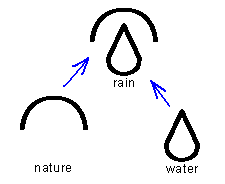
Facebook Earth Language Archive Part 3 Relating to friends' opinions, Between cultures
English Home,
Japanese Home
1[human, plant, heart, life]
2[the middle circle variation]
3[Relating to friends' opinions,
Between cultures, etc.] 4[phonetics]
Basic Idea (26) The rain

Water is dripping from the sky. So this symbol means
"rain."
Also rain is the main phenomenon to circulate natural water on this planet.
You might think the symbol {cloud water} would be more reasonable,
but "rain" is
a kind of root word to be able to combine with other meanings.
So it was made as
simply as possible.
Basic Idea (27) Various rain
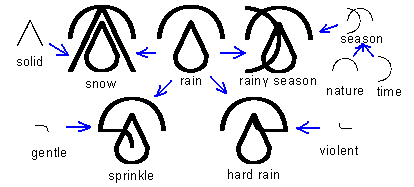
Rain falls in various ways.
Basic Idea (28) Natural water is not always as rain

It changes the figure in various ways.
Basic Idea (29) Faith, belief
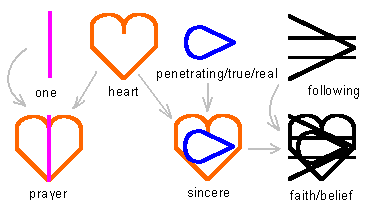
When you pray, you focus your heart on one thing.
When
praying something with others, everyone's hearts gather into one.
"Prayer" holds
strong intention.
The blue symbol in the image looks like a drill head penetrating through the
universe
to make an empty tunnel to listening to the truth from the infinite
world.
Sincere heart must have it beyond his/her intention;
and when the heart
follows along listening to the truth,
it must be called "faith/belief." That was
my idea,
when I made the EL dictionary item for "belief."
Basic Idea (30) An bases overlay and its representation with single bases
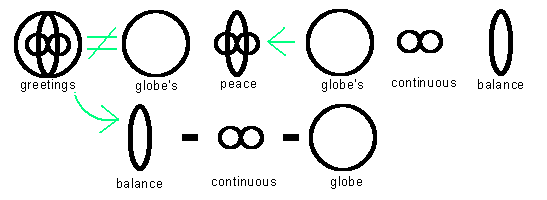
The almighty greeting symbol (for hello, good day! etc.) is
represented by the bases overlay
directly meaning "global peace." But the usage
of the overlay is only for greetings
as a fundamental character.
When you write the greeting symbol as its element single bases,
you need hyphen
between the three bases.
(Hyphen shows that its left and right bases are
actually in one symbol.
The way looks longer than without hyphen, but the amount
of keys
to hit is the same with the Earth3 EL font program.)
When plural symbols are next to each other without hyphens or any prepositions,
the front symbol modifies the following one in an EL sentence.
I once explained about hyphen at the 18th of this series. Please don't forget
about hyphen.
# About hyphen:
http://www.earthlanguage.org/english/defi/gcpunct.htm#hyphen
# More about the greeting symbol:
http://www.earthlanguage.org/english/defi/idiom.htm#Greet
# Naming of living creatures as one symbol and with hyphen:
http://www.earthlanguage.org/illust-dic/Classification.htm
Between cultures
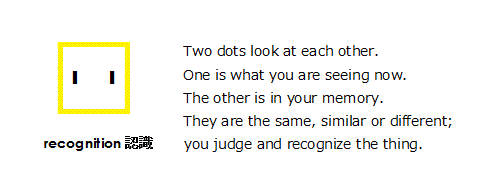
A newborn baby can’t recognize
anything, because it has no experience and memory yet.
To recognize things, each
person has his/her own experiences in their culture.
So actually even if seeing
the same thing, the recognitions by people
are never completely the same.
A common language has to be set with common rules;
and yet EL wants to venerate
the differences between cultures and personalities.
To do that, EL has its
unique grammar and methods.
[Call for examples of
differences of recognition between cultures]
You might have experienced some
confusion/trouble because of differences
between what you thought as a
commonsense and the way of another culture/language.
Could you share them with
us? I’d like to check if the EL system is ready to reduce
the kind of troubles.
I’ll try to introduce my experiences too.
あなたが体験した言語・文化の差による問題点を地球語ページに
お聞かせ願えませんか?地球語文法の更なる改良に役立てたいと思います。
Between cultures [yes/no]
Until middle of 40s I had never used English. When I started English
conversations,
I was completely in Japanese habit: standing on the other side to
listen to him/her.
So for a question with a negative verb, as “Didn’t you do
…?,”
my brain naturally going to answer “Yes (I didn’t)” or “No (I did).”
oppositely from the English answer, thinking if the other’s thought was true or
not.
Each time I took a moment to be careful to answer a question.
In EL, I prepared clear single-symbol-answering ways for various types of
questions.
A simple system is easy to understand, and simplicity makes signing
easier.
ここでは「はい」「いいえ」の答え方の日英語の違いを紹介しました。
英語民にはこんなシステムのせいで間違いが起きるとはふつう想像もしないですからね。
地球語での答えかたはこのような設定ですが、いかがでしょうか?
Examples of EL answers:
地球語でのいろんな返事の仕方
Between Cultures [Interrogatives](質問)
I also realized that my
focal point of a speech sentence had been at the end. In a Japanese speech,
the
sign of question comes at the end of a sentence.
Raising the pitch of voice up
at the end, even a normal descriptive speech can be a question.
Through this
custom, I often mistook the other’s question as just his/her descriptive, since
no pitch accent at the end.
In a global conversation, it
would be kinder if what the purpose of a sentence was CLEARLY shown
at the very
beginning of a sentence; also helpful by showing WHERE the point of a inquiry
is:
http://www.earthlanguage.org/english/defi/idiom.htm#57
今回は、会話の中でふつうの叙述かまたは相手への質問なのかが
聴き取りにくかった私の体験を紹介してます。
45歳まで英語を使ったことがなかったので
文の終わりにフォーカスして聞く癖がぬけず、また語尾が上がらないと質問と捉えにくかった私でした。
地球語では文頭で「これから質問しますよ」の明瞭な合図をし、質問の問題点にも疑問符を置く工夫をしました。
手話でも判りやすいと思います:
http://www.earthlanguage.org/jsyst/didiom.htm#quest
Could you share your
experience with us about a trouble
between cultures like this? It’s for deeper
development of the EL grammar.
あなたが体験した言語・文化の差による問題点を地球語ページにお聞かせ願えませんか?
地球語文法の更なる改良に役立てたいと思います。
Between Cultures [Why?](なんで?)
Sometimes I experienced that
the other suddenly got sullen in a peaceful conversation with me in English.
I
was wondering why; and after years finally found the reason. It was because of
“Why?”
I’m a person who often wonders why for many things. In a casual Japanese
conversation,
when something strange happens, other people also say just “Nande?” (Why?),
wondering to him/herself, touching a chord with others. In the same feeling, I
spoke just “Why?”
when watching TV news. But English language needs a full
sentence.
“Why?” is a rude way to say, ”Why did it happen? (you must know the
reason)”
The other had to feel, “No way I had to know why!” and I had to say, “I
wonder why” in English in this case.
After above experience, EL
clearly distinguishes expressions between a question
and just wondering to
oneself, using the same bases in different locations:
http://www.earthlanguage.org/english/defi/idiom.htm#wonder
私はまともに英会話を習ったことがないので渡米まもなくのころは失敗の連続でした。
会話中に相手が急に不機嫌になったこともありました。
「なんで?」のつもりで
「Why?」と言ってたのだと何年も後で気づきました。英語では「お前は知ってるはずだ、
なぜなんだ?」と無作法に尋ねたことになるのですね、
TVニュースの奇妙な話題のわけなんて
「俺の知ったことか」と不機嫌にもなりますよ。英語は自他を分け自己主張するのに対し、
日本語は相手との共感を探る方向に会話することを思い知った例でした。
地球語では誤解を招かないよう質問と自問の表現をクリアに分けました。:
http://www.earthlanguage.org/jsyst/didiom.htm#isnt
Between Cultures [Imperatives](依頼)
For a request, American and Japanese people both distinguish the ways in
businesslike
or in a politely hesitate manner. But when I got a request from a
Chinese man in English,
I felt like I was commanded. Also many Chinese say “he”
for “she.”
And later I learned that Chinese “he” = both he and she: they don’t
distinguish them.
Chinese language is very rational, so probably they don’t so
differentiate the request manners in their daily lives.
To avoid unnecessary
friction, EL has prepared manners to ask something to others,
between in
business, commandment and polite way:
http://www.earthlanguage.org/english/defi/idiom.htm#55
他に何かを頼むとき、日英語では丁寧なお願いとビジネスライクな「・・(して)ください」を
使い分けますが、中国人英語で依頼されたときには命令されたように聞こえました。
中国語は彼・彼女も区別をしない合理的な言語なので、何かを要求する場合には
同じ表現で済ませるのかもしれません。いらぬ摩擦を避けるため、地球語では
命令・依頼・丁寧なお願いを単純に文頭で区別して認識できるようにしました。
My Garden Now
(The photo is missed)
In the EL website in 2010, there was a long photo report series,
“Story of My
Vegetable Garden” in EL, English and Japanese.:
http://www.earthlanguage.org/Garden/gdn1.htm
The garden now
is about five times larger than that, including the roadside slope
for flowers
and small trees, also a spiral garden that I built recently with old broken
concrete pieces.
I’ve been busy to manure and to seed there. The garden and our
forest have been honestly telling me
a lot about the nature system. I listen to
it through my muscles and cells; and EL is always with me.
A tip of instruction to use the EL Dictionary:
http://www.earthlanguage.org/dic/dic.htm
In an English dictionary, a word usually has plural
meanings.
And the meanings are shown as 1)…, 2)…, 3)… But usually an EL base has
only one definition
or a grammatical function. The dot base is used for ways,
but you can distinguish the usages
by the arrangements.
Each meaning of a base is shown under [definition (single)]
When it’s compounded with another base/ideogram, sometimes a base adds a meaning
in different way,
depending on another base/ideogram to form a picture-like
fundamental ideogram or
to show a compounded meaning. You see 1), 2), 3) in the
EL dictionary; and the items are for what images
the base adds when forming a
base-overlays.
Please don’t think there are 1), 2), 3) meanings in a base
itself. A base has a single
and simple definition, so overlays can be created
endlessly and work being distinguished each other.
New Settings
I think I'm going to
change the setting of a few symbols of the EL dictionary, respecting Jouni's
long time usage.
Blue symbols are older, and red ones are new. What do you think?

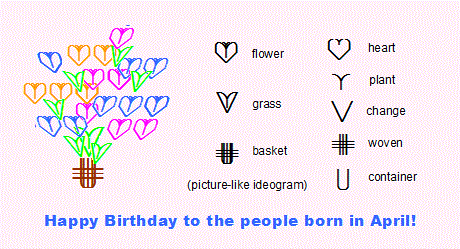 A
pictograph with another example including [woven]-ideogram
A
pictograph with another example including [woven]-ideogram